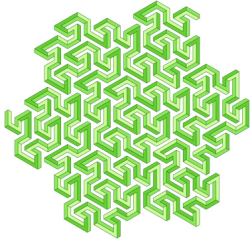Right, let’s be havin’ ya! My name’s Christian Perfect, I’ve got some links, and you’ve got some eyes. Aperiodical Round Up 8, arriving later than scheduled at Platform Your Face.
I’ll start with some made-up maths. Too often, writers end up putting themselves in a corner and needing a maths problem for their brilliant savant character to solve. There are a couple of considerations when using maths in fiction: it needs to look genuinely difficult, and if you’re making a film it needs to looks good when your genius protagonist scrawls it on a blackboard/napkin/the love interest’s chest. Famously, Good Will Hunting satisfied the latter criterion but not the former – Bill H astounded the professors by solving an aesthetically pleasing but pretty trivial problem from linear algebra. The producers of the recent Sherlock Holmes sequel made quite a hullabaloo of going to the effort to commission a proper period-appropriate bit of maths for Moriarty to use in the bits of the film when everything wasn’t exploding.
 Or if you don’t feel like making a good movie, you could just pick a well-known open conjecture, declare that one of your characters has solved it, and proceed to write the rest of a thriller (they’re always thrillers) that will wind up mathematicians in the audience tighter than an obsessive-compulsive’s grandfather clock. Some examples off the top of my head: P=NP (Travelling Salesman), Goldbach’s Conjecture (Fermat’s Room), Goldbach’s Conjecture again (The Calculus of Love). It turns out that the top of my head doesn’t have too much on it, so it’s a spot of luck that Alex Kasman maintains the MathFiction page, listing “over one thousand short stories, plays, novels, films, and comic books containing math or mathematicians”. I bet most of the maths mentioned there isn’t even bad! Oliver Knill’s similar Mathematics in Movies page focusses just on films but contains video snippets of the relevant scenes.
Or if you don’t feel like making a good movie, you could just pick a well-known open conjecture, declare that one of your characters has solved it, and proceed to write the rest of a thriller (they’re always thrillers) that will wind up mathematicians in the audience tighter than an obsessive-compulsive’s grandfather clock. Some examples off the top of my head: P=NP (Travelling Salesman), Goldbach’s Conjecture (Fermat’s Room), Goldbach’s Conjecture again (The Calculus of Love). It turns out that the top of my head doesn’t have too much on it, so it’s a spot of luck that Alex Kasman maintains the MathFiction page, listing “over one thousand short stories, plays, novels, films, and comic books containing math or mathematicians”. I bet most of the maths mentioned there isn’t even bad! Oliver Knill’s similar Mathematics in Movies page focusses just on films but contains video snippets of the relevant scenes.
Anyway, the reason I brought this up is that Philibert Schogt needed some maths for a book he was writing. In books, unlike in films where you have to show someone furiously scribbling symbols, you can be very vague about what exactly the mathematics involved is. Schogt has uploaded an essay to the arXiv describing his process for making up a plausible bit of non-maths, and how the “wild numbers” he didn’t really describe inspired some mathematicians to make them real.
 Ducks! Discrete Mathematics with Ducks! Quack!
Ducks! Discrete Mathematics with Ducks! Quack!
If a bird heard the word ‘surd’ from a nerd, would it be disturbed? First we need to know why the nerd purred the word ‘surd’. What if the nerd averred that the word ‘surd’ occurred first, slurred, in Urd(u)? Is that lineage of the word ‘surd’ preferred?
Duh I dunno maybe let’s ask a linguist.
Did you know that as well being an excellent dude, Pafnuty Lvovitch Chebyshev was an excellent dude? It needs saying twice. Back in the day, stepper motors and electrical bitbots hadn’t been invented yet, so if you wanted to draw a shape you had to make a linkage to do it for you. Some proud Russians have taken the time to apply their considerable skills towards making a lovely site about the linkages and mechanisms Chebyshev invented.
Talking of linkages, here’s one that draws the lemniscate of Bernoulli, a.k.a. the infinity sign, for you. Nobody need ever fail to draw the infinity sign properly again.
The famous proof convinces a moron in a hurry that all numbers are interesting. There’s certainly evidence that there are some interesting numbers because people collect them, notably Tanya Khovanova’s Number Gossip and Shamos’ catalogue of the real numbers (warning, huge PDF). They both tend to cover the lower end of the scale though – if a least uninteresting number does exist, it isn’t beyond the bounds of imagination that it’s bigger than anything covered in those fascinating compendia.
 Robert Munafo’s collection, Notable Properties of Specific Numbers, can hold its head high. Munafo is a Theodore Roosevelt of number-gathering – everything is fair game, no matter how large or how fearsome. Even the index for skipping between pages is a cheerful tourist of the number line, taking intervals whenever something interesting pops up instead of planning ahead and stopping at evenly-spaced markers. When you get to the last couple of pages, the piles of superscripts necessary to denote numbers make them look like perspective drawings of roads made by a TomTom that’s lost its marbles.
Robert Munafo’s collection, Notable Properties of Specific Numbers, can hold its head high. Munafo is a Theodore Roosevelt of number-gathering – everything is fair game, no matter how large or how fearsome. Even the index for skipping between pages is a cheerful tourist of the number line, taking intervals whenever something interesting pops up instead of planning ahead and stopping at evenly-spaced markers. When you get to the last couple of pages, the piles of superscripts necessary to denote numbers make them look like perspective drawings of roads made by a TomTom that’s lost its marbles.
But suppose you’re the worst kind of person and find only one number interesting. I’ve got just the thing for you! Incorrectly ascribing mystical properties to the objects around you becomes as easy as looking at something with this handy golden ratio finder card.
Some people find numbers interesting in a different way. The shapes of the digits themselves are subjects of serious study. I can’t remember why I was looking, but I found a freely available database of samples of handwritten digits provided by Yann LeCun and Corinna Cortes. There isn’t much to see there unless you’re a robot, but I thought it was worth mentioning.
Talking of robots looking at things, here’s something we can all appreciate: the Rijksmuseum recently did a rather good job of redesigning its website, and made all of its data about its collections publicly queryable. Not only have they tagged everything they’ve got, they’ve done it in both Dutch and English! Of course I immediately searched for everything to do with maths. I found these trendy dudes on horseback doing angles, as well as a chap whose efforts to get to sleep counting sheep seem to have got out of hand, and a seventeenth century computer cluster. And that’s just the engravings! I like the Rijksmuseum.
Time for me to lay it out straight, like a tablecloth or a trustworthy ruler. I have in the past, in this very column, expressed my expanding distaste for NP-completeness proofs. I’ve said that there are enough, and that we do not need any more. I was wrong about that, and for being wrong I apologise. Vargomax V. Vargomax’s SIGBOVIK presentation, “Generalised Super Mario Bros. is NP-complete“, is a worthy addition to the academic discourse.
Did you notice at the top of the page that the randy mathematician in Edward Frenkel’s short film was played by the mathematician Edward Frenkel? He seems a pretty cool customer. Another cool mathematician is Allen Knutson, who had sufficient sang-froid to leave the last image from his long-gone office webcam up on his homepage because it shows his hand moving to take it away.
 Impossible shapes are pretty nice. Fractals can hold one’s interest. Impossible fractals, as drawn by Cameron Browne, gave my brain a good firm tickling. I think what would really add a lot would be some animations running along them. Maybe someone will do that one day. Actually, constructing fractals is pretty hard, especially if it’s impossible, so it might not be a bad idea to enlist some help from something there are uncountably many of. I certainly don’t feel capable of counting the teeming plenitudes of germbugs with whom we share this existence, so the paper Algorithmic Self-Assembly of DNA Sierpinski Triangles is probably worth a read.
Impossible shapes are pretty nice. Fractals can hold one’s interest. Impossible fractals, as drawn by Cameron Browne, gave my brain a good firm tickling. I think what would really add a lot would be some animations running along them. Maybe someone will do that one day. Actually, constructing fractals is pretty hard, especially if it’s impossible, so it might not be a bad idea to enlist some help from something there are uncountably many of. I certainly don’t feel capable of counting the teeming plenitudes of germbugs with whom we share this existence, so the paper Algorithmic Self-Assembly of DNA Sierpinski Triangles is probably worth a read.
That seems to be the end of the links for now. I’ll end with this plippy-ploppy little video of a reaction-diffusion system trying its hardest to be a big-boy cellular automaton. Ladies and gents, SmoothLife:
[youtube url=https://www.youtube.com/watch?v=KJe9H6qS82I&feature=player_embedded]
Until next time!